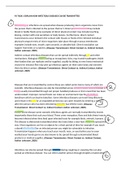P3 TASK 1 EXPLAIN HOW INFECTIOUS DISEASES CAN BE TRANSMITTED
Direct contact infections are spread when disease producing micro-organisms move from
the person that is infected to the person that isn’t. Direct physical contact may include
blood or bodily fluids some examples of direct physical contact may include touching,
kissing, contact with oral secretions or body lesions. Furthermore, direct contact
transmissions occur between the contact with tissues or fluids of the infected individual
physical transport entry of micro-organisms take place through mucous membranes
examples include eyes, mouth, open wounds, or abraded skin. Direct inoculation can
happen from bites or scratches. (Disease Transmission: Direct Contact vs. Indirect Contact,
Author unknown, 2020)
Indirect contact infectious diseases that can be spread indirectly through air and other
mechanisms. Biological vectors acting as mosquitoes, ticks, may transfer pathogens inside
their bodies that can replicate and be supplied, usually by biting, to new hosts mechanical
vectors for instance flies may pick up infectious agents on their outer body and transmit
them by direct contact. (Disease Transmission: Direct Contact vs. Indirect Contact, Author
unknown, 2020)
Diseases that are transmitted by vectors these are called vector-borne many of which are
zoonotic. Infectious diseases can also be transmitted across contaminated food and water E.
coli is usually transmitted through not proper handled produces or from meat that has been
undercooked. Improper canned foods can make an environment ripe for clostridium
botulinum which can lead to botulism. Some infectious diseases can travel long distances
and remain in the air for an expanded period you can catch measles by entering a room
after the person who has been infected by measles has left the room. (Disease
Transmission: Direct Contact vs. Indirect Contact, Author unknown, 2020).
Vector borne disease some zoonotic infectious agents are normally transmitted by insects
importantly those that suck your blood. These cover mosquitos, fleas and ticks these insects
become infected when they feed upon infected hosts for example birds, animals, humans.
The disease is afterwards transmitted when the insect bites a new host malaria is spread this
way. Most organisms can live on objects for a short period of time for example if you touch
a doorknob shortly after an infected person you might be vulnerable to infection.
Transmission happens when you touch your mouth, nose, or eyes before you’ve even
washed your hands germs are also known to be spread through contaminated blood
products or medical supplies. (Disease Transmission: Direct Contact vs. Indirect Contact,
Author unknown, 2020)
Infections can also be spread through droplets during coughing or sneezing this can also
spread an infectious disease. You can infect another person through droplets created when
1
, you speak but since droplets fall to the ground in a matter of seconds this type of
transmission requires close contact. An example of a disease caused by droplet infection
would be influenza. (Disease Transmission: Direct Contact vs. Indirect Contact, Author
unknown, 2020)
Some infectious diseases can be transmitted from an animal to a person this happens when
an infected animal bites or scratches you or when handling animal waste. There are five
main ways infections are spread like skin contagions which are spread by physical contact,
the spread of droplets, cold, strep throat, contaminated or dirty items, bowel movements,
exposure to blood these are the five main reasons why infection is spread. (Disease
Transmission: Direct Contact vs. Indirect Contact, Author unknown, 2020)
Human-human
There are many ways in which infectious diseases can be passed on from person to person
for example through direct physical contact like kissing and touching an individual who
already has the infection a disease that can come about from this is strep throat.
Animal-human
Animals are also known to carry harmful microbes which can be transmitted to individuals
making them ill these are recognised as zoonotic diseases which are caused by dangerous
2




